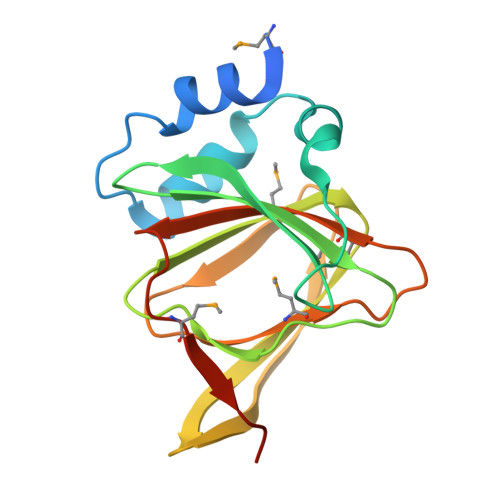Structures of Arg- and Gln-type bacterial cysteine dioxygenase homologs.
Driggers, C.M., Hartman, S.J., Karplus, P.A.(2015) Protein Sci 24: 154-161
- PubMed: 25307852
- DOI: https://doi.org/10.1002/pro.2587
- Primary Citation of Related Structures:
4QM8, 4QM9, 4QMA - PubMed Abstract:
In some bacteria, cysteine is converted to cysteine sulfinic acid by cysteine dioxygenases (CDO) that are only ∼15-30% identical in sequence to mammalian CDOs. Among bacterial proteins having this range of sequence similarity to mammalian CDO are some that conserve an active site Arg residue ("Arg-type" enzymes) and some having a Gln substituted for this Arg ("Gln-type" enzymes). Here, we describe a structure from each of these enzyme types by analyzing structures originally solved by structural genomics groups but not published: a Bacillus subtilis "Arg-type" enzyme that has cysteine dioxygenase activity (BsCDO), and a Ralstonia eutropha "Gln-type" CDO homolog of uncharacterized activity (ReCDOhom). The BsCDO active site is well conserved with mammalian CDO, and a cysteine complex captured in the active site confirms that the cysteine binding mode is also similar. The ReCDOhom structure reveals a new active site Arg residue that is hydrogen bonding to an iron-bound diatomic molecule we have interpreted as dioxygen. Notably, the Arg position is not compatible with the mode of Cys binding seen in both rat CDO and BsCDO. As sequence alignments show that this newly discovered active site Arg is well conserved among "Gln-type" CDO enzymes, we conclude that the "Gln-type" CDO homologs are not authentic CDOs but will have substrate specificity more similar to 3-mercaptopropionate dioxygenases.
- Department of Biochemistry and Biophysics, 2011 Ag & Life Sciences Bldg, Oregon State University, Corvallis, Oregon, 97331.
Organizational Affiliation:



















